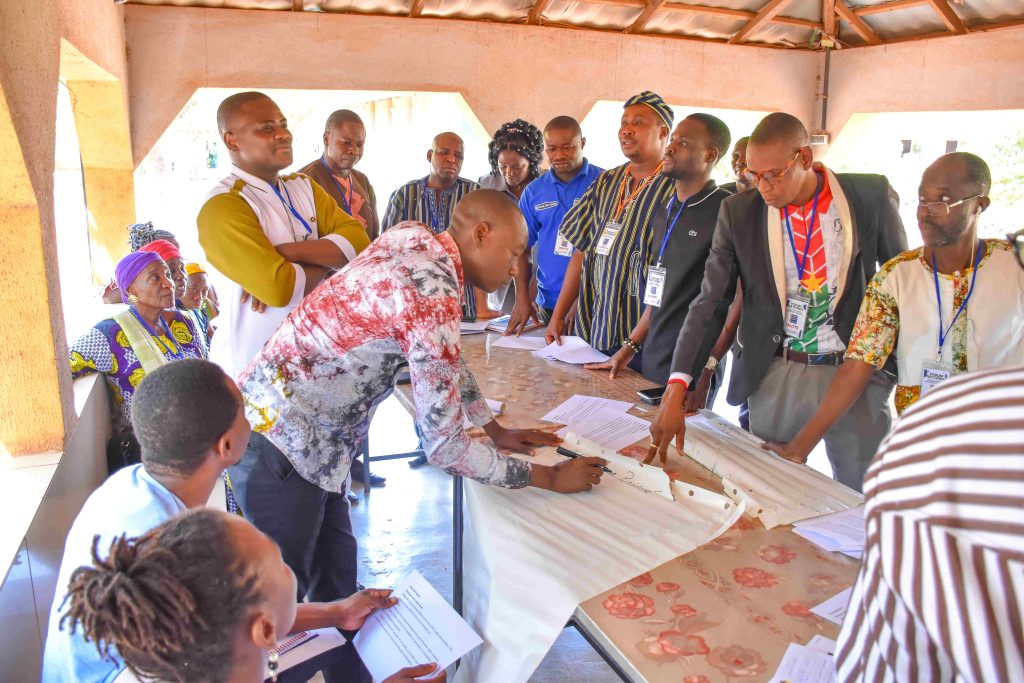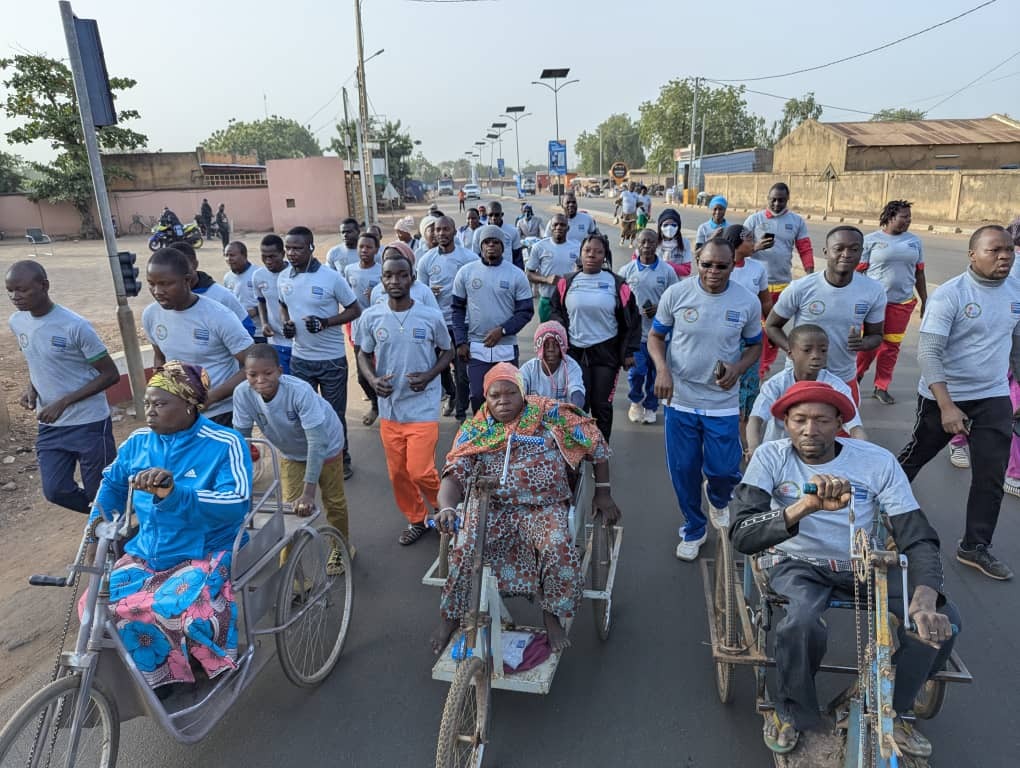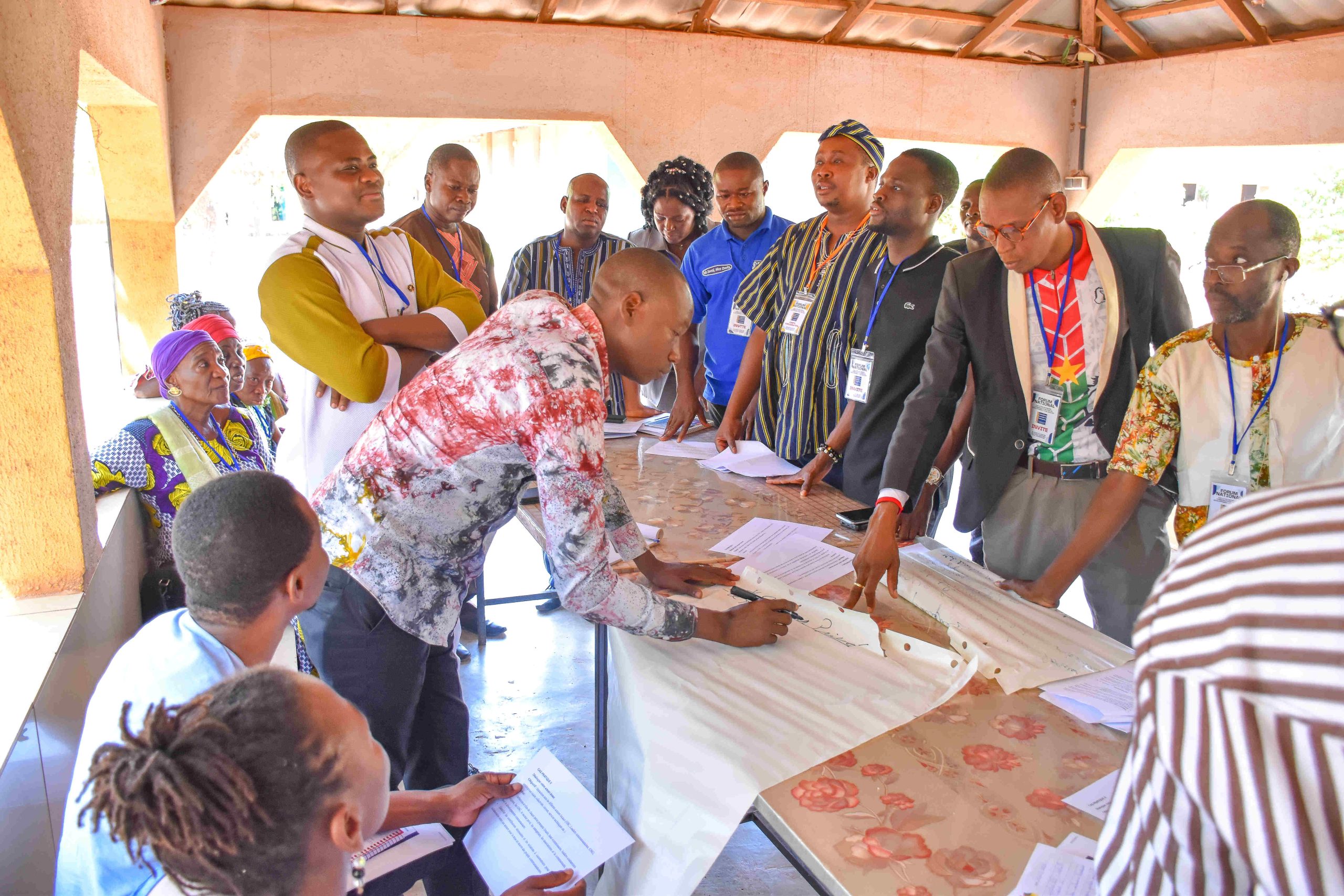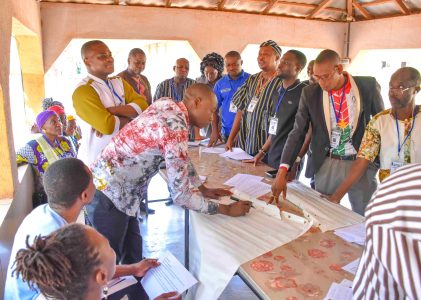Lenie Hoegen Dijkhof, Abdoulaye Sawadogo and Malo Debe
According to the CIVICUS Monitor 2024 report, Burkina Faso’s civic space was downgraded to “repressed,” dropping 12 points from 46 to 34 as the military junta silenced critics and censored media during a prolonged transitional period. The country continues to face overlapping challenges: persistent insecurity, humanitarian needs, economic pressures, and a constrained civic space. Yet, amid these crises, local resilience, modest economic growth, and efforts to improve service delivery remain visible.
For the past four years, the Giving for Change programme has been implemented by the Association Burkinabe de Fundraising (ABF) in six regions across the country. To learn how the work has shaped up, Ese Emerhi (Global Fund for Community Foundations, GFCF) and Barry Knight (GFCF advisor) caught up with the ABF team to learn more about their work in building community philanthropy through the Giving for Change programme and to reflect on the impact of the work so far. The interview was conducted in May 2025 and has been edited for length and clarity.
Let’s dive into some introductions! In this interview, we’d love to have a relaxed chat about your experiences. We’re curious to hear about your backgrounds, what Giving for Change has brought to your work with the Association Burkinabe de Fundraising in Burkina Faso—the highlights and challenges—and how you now view the world from your unique perspective. First, tell us a bit about yourselves.
Lenie Hoegen Dijkhof: Before coming to Burkina Faso, I worked at the Liliane Foundation in the Netherlands. Liliane Foundation is a Dutch NGO founded in 1980 as a special fund for children and young people with disabilities in developing countries. I was the head of the fundraising and public information department, and I traveled extensively for work. That was nearly 20 years ago. My focus was on making documentaries with Dutch television and newspaper journalists about the impact of the work on the lives of families with disabled children, and not so much in the modern ways of fundraising. At the age of 50, I decided to leave the foundation and relocate to Burkina Faso, one of the countries where the foundation had done a lot of work. I thought I could contribute more this way and learn a lot.

Abdoulaye Sawadogo: I’m currently the executive director of the Association Burkinabe de Fundraising(ABF), and I’m one of its founding members. Before ABF, I worked at one of the country’s largest hospitals, supporting local associations working on HIV/AIDS with capacity-building training. I also previously worked with the CLS/IST, helping local associations to strengthen their capacity-building training. When we first started ABF, we aimed to support CBOs with fundraising on micro-projects that would lead to tangible outcomes. We realized that most projects funded by donors did not meet community needs. Therefore, at ABF, our focus was on building the capacities of CBOs in local resource mobilization.
Malo Debe: I started my career as a primary school teacher. While working as a director of a local school. I attended human resources training and was trained as an accountant. I worked as an accountant for eight years before joining ABF. At ABF, I received additional training on resource mobilization through the Change the Game Academy. I’ve been a certified trainer for Change the Game Academy since 2021 and was appointed to lead programs at ABF in 2023.
Like farmers, we have prepared the land and planted the seeds for change. The seeds need time to grow roots before we can harvest them.
How’s the Giving for Change programme going in Burkina Faso? What significant achievements can you point to after four years of the programme?
AS: One of the biggest success stories of the Giving for Change programme is the full commitment of all the stakeholders and other actors involved. Giving for Change is not like your typical donor-funded programme, where the directives are top-down. Instead, it’s about building people’s capacities to advocate with government agencies to change specific policies that affect their lives. It’s been a transformative mindset shift, where communities drive the change they want to see, implementing plans to achieve success.
We often talk about a mindset shift when it comes to this type of work with communities—communities that are more in the driver’s seat, as you say. Could you elaborate a bit more on how this mindset shift occurred?
AS: First, we established accountability among the leaders of all the communities of practice (CoP) regarding their respective projects. This straightforward action significantly contributed to building trust with others, as they observed that the projects were progressing as intended. The second thing we did was to ensure that all the CoP leads and trainers came from the districts or regions where the work was taking place. It became a competition among CoP leads from the other regions to showcase their work. Having the sons and daughters of the districts leading on the project makes the whole process more legitimate. Each CoP lead chose a thematic topic relevant to their organizations and districts. They had to show their work to government agencies to achieve their objectives – this collaboration also strengthened their legitimacy in the eyes of the communities. Lastly, all our partners have undergone training at the Change the Game Academy. As the Giving for Change programme was starting, we invited all of them to think and plan with us.
MD: I’m a direct product of the mindset shift transformation that Abdoulaye is talking about. I learned how to become an advocate, primarily through the Change the Game Academy. The Giving for Change programme introduced another element to our work, encouraging communities and CoPs to organize themselves more effectively and advocate for their rights. However, I must admit that, at first, it was not easy to get people to understand that they are in control of the projects they implement. I recently had one member of a CoP ask why the Giving for Change programme was arriving so late to the community; he had seen how working differently can positively impact the community, and he was lamenting that just as the change was happening, the programme was ending.
LHD: I’ve worked on disability rights for children for more than 30 years with different organizations, and there’s so much talk about policy-to-practice that leads to no real change. I realized that, instead, practice-to-policy is more effective, working from the ground up, and this is the lens that the Giving for Change programme brought; it’s a more difficult route, but it’s the most effective. It wasn’t just “talk” but “action”. We now have more empowered voices in the process; the invitation to share their voices and perspectives on the project was vital, and that’s where the change happened.

As Abdoulaye has said, there’s a greater sense of shared accountability with the work. We have 60 CBOs involved in the CoPs through Giving for Change, with eight regional leads, and ABF acting as the national partner – we each have our role to play, and together we make a good program. The National Philanthropy Forum we host annually brings many of these local voices together. We’ve seen how their collective power has grown over the years, and they genuinely feel responsible for making the programme a success; they take it personally.
What are the main challenges you are facing right now with the work?
AS: With the careful monitoring of the programme over the past four years, we’ve identified a few challenges:
- The biggest challenge is continuing our gains after the programme ends in 2025. Like farmers, we have prepared the land and planted the seeds for change. The seeds need time to grow roots before we can harvest them, and it would be a shame to let them die. We are currently investing in submitting grant proposals in the same spirit as Giving for Change to new donors, and we hope they will succeed.
- Most of the communities where we work are in rural settings, and they are unaware of some of the new policies regarding advocating for their rights. Even as we work to make resources available and create more awareness around these national policies, we realize that though these laws and policies exist, they are not enforced, impacting our outcomes.
- Despite communities’ resilience, insecurity hinders the implementation of some of our projects. Our message to funders at the international level is that they need to trust local partners in our work, especially regarding security concerns in the country.
How are you facing the future, especially with the Dutch Ministry of Foreign Affairs (and other bilateral partners) pulling away from funding these programs? A follow-up question is this: Some donors argue that local resources can mitigate the need for international aid. How would you address such criticism?
AS: We can secure funding through the Change the Game Academy and other development partners, such as the UNDP and the Islamic Development Bank. The type of transformative change that Giving for Change aspires to cannot be achieved fully in five years; we need 15 years to see the change take root. Towards the end of last year, we initiated discussions with consultants affiliated with USAID regarding the possibility of new funding. We were part of a small consortium with other organizations that put together a proposal. Then, in January, with the dismantling of USAID, our hopes about the new funding were dashed.
Our message to funders at the international level is that they need to trust local partners in our work, especially regarding security concerns in the country.
LHD: The simple answer to whether international aid is still needed is yes. Saying there’s no need for international assistance is like asking us, civil society organizations from the Global South, to jump into a pool without water! We need to fill the pool with water first before we can dive into the pool without hesitation. On our part, all new proposals now include a local contribution element of at least 25%, with the remaining funds to be provided by donors, demonstrating our commitment and true partnership. Our strategy has shifted to a co-financing approach, so we are seeking new donors who share this perspective. We are also steadfast in our resolve to say no to the wrong type of partnership; it has to be aligned with our principles in co-creating solutions.
What can the programme do to help sustain some of the achievements you’ve described?
AS: Though we have progressed in the six regions where we currently work, seven other regions are not part of Giving for Change. It’s not just about maintaining our achievements but also about expanding into new regions. What would be helpful to us from Giving for Change is the inclusion of advocacy materials (blogs, two-pagers, videos, etc.) that showcase the impact of our work in our proposals to attract new donors.
MD: I also think that what is happening with the withdrawal of certain strategic partners is that these partners have not taken the measure of knowing that we have common challenges such as climate change, poverty, hunger, humanitarian crises, the defence of human rights, and many others. So, suspending funding for our countries, arguing that we can develop ourselves, is a refusal to recognise the need to find solutions to common challenges. Even if we are already mobilising resources at the local level, it is always important to know that this is a work in progress that deserves everyone’s support. This means that the Giving for Change programme will need to be continued in some form to ensure that the achievements are sustained.

